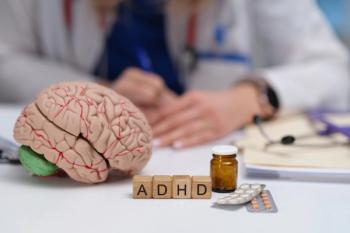
- Consultant for Pediatricians Vol 8 No 7
- Volume 8
- Issue 7
Toilet Training: Strategies for Success in Children With Developmental Disabilities
The readiness of a child with a developmental disability to begin toilet training is determined by his or her achievement of the requisite developmental milestones rather than by chronological age. The specific strategies used in training are determined by the child's specific diagnosis.
Success at toilet training is a significant milestone for every child and his or her family. Through mastery of this most basic self–help skill, the child gains independence and the parents are freed of the considerable time, effort, and cost previously required. Succeeding at toilet training is just as important for children with developmental disabilities and their families; however, these children may need specific methods and a different time frame to achieve the desired goal.
CONTINENCE: NOT ONE SKILL, BUT MANY
To achieve continence, a child must master a series of skills (Table 1). First, he has to "feel it coming." Some parents recognize by the look on their child's face that he knows he "needs to go." Next, the child has to be able to "hold it in." When parents see their child do the "pee pee dance" or the "doody dance," kneel on a heel, or stand very still in an effort to postpone urination or defecation, they may be inclined to view such attempts to hold it in as avoidance techniques. Instead, parents can be encouraged to recognize the ability to hold it in as an important and necessary step toward continence. At this point, the child must be able to communicate, either with words or gestures, his need to get to a toilet; this skill is essential for those times when he is in unfamiliar environs or far from a known bathroom. Motor skills are also needed to get to the bathroom physically.
Many children who are not yet toilet trained will regularly go to the same spot in their home to have a bowel movement-for example, behind a couch, under a table, or to their own bedroom. These children are demonstrating a number of toilet readiness skills: feeling it coming, holding it in, and getting to another place to toilet privately. However, rather than "toilet trained," they are "couch trained" or "dining room table trained"! Again, taking this perspective is helpful because it encourages the family to recognize what the child already can do, rather than focusing solely on his failures.
Once in the bathroom, the child needs the motor skills to pull pants and underwear down and to climb up and sit comfortably and securely on the toilet. The ability to relax while sitting is also essential: you can't poop when you're clenched. For this reason, one of the first things we ask all children to do when teaching them to use the toilet is to practice sit–down times; the goal is to master the essential skill of relaxing while sitting. Typically, sit–down times take place 30 minutes after meals, to take advantage of the gastrocolic reflex. Each sit lasts 10 minutes, and the goal is simply to practice being relaxed on the toilet, not immediately to produce urine or stool.
The child now needs to empty the bladder or evacuate stool. Stool evacuation requires pushing. A child can use the simple biofeedback technique of placing one hand on the lower abdomen while blowing, and feeling the abdomen protrude as a sign of a successful Valsalva maneuver. Pretending to blow out birthday candles or blowing on a kazoo or other party blow toy are additional options. Wiping comes next, a skill that requires fine motor coordination and hand strength. Getting off the toilet, pulling up underwear and pants, flushing, and hand washing complete the sequence.
Breaking toileting into these 13 steps not only clarifies the skills needed to consolidate training but also provides a framework for identifying the many skills a child may already possess. For typically developing children who are struggling with toilet training, breaking the toileting process into these discrete skills focuses frustrated parents on the many abilities the child does demonstrate and lays the groundwork for a plan to add the small steps still needed to produce continence.
TOILET TRAINING THE CHILD WITH DISABILITIES
The same sequence of 13 steps applies to toilet training children with developmental disorders. Each child will have to master all of them. We often start with toilet sitting and then slowly add flushing, wiping, going while in the bathroom, then going while on the toilet. For each step, small advances bring small reinforcements, from stickers on a chart to special activities with parents.
However, the methods used to train children with disabilities take into account the limitations, sensitivities, interests, and learning rates specific to the disorder involved. Each diagnosis has its own unique set of considerations, both strengths and weaknesses, that must be kept in mind when working with affected children and their families.
In the United States, most children are toilet trained by age 3 years.1 The necessary skills to toilet independently begin to emerge before 2 years and are typically consolidated by 3 years (Table 2). Thus, a child has to be at a developmental and physiological "age" of at least 2 years-and more likely 3 years-to achieve continence. Regardless of the child's chronological age, he needs to have the communication and motor skills of a toddler to use the toilet independently and consistently.
It may be helpful to ask the parents, "What age does your child seem to be?" or "At what age level are most of your child's skills?" Reviewing basic developmental milestones can also be useful in determining a child's readiness for toilet training. The developmental skills of a 2–year–old include combining 2 words into phrases, following simple instructions, scribbling, kicking a ball, and beginning to run. Three year– old skills include using 4– and 5– word sentences, following 2– and 3– step commands, drawing straight lines and circles, running easily, and pedaling a tricycle. Asking about these skills can help you estimate a child's developmental level.
DIAGNOSIS–SPECIFIC TOILET TRAINING PLANS
Attention–deficit/hyperactivity disorder (ADHD). ADHD is a neurobiologically based disorder that affects between 4% and 7% of children.2 The diagnosis is made by gathering a detailed history of behavior at school and at home.3 Symptoms must have been present before age 7 years, occur in more than one setting, and significantly impair function. ADHD is more often diagnosed in boys than in girls and is frequently accompanied by comorbid diagnoses such as learning disorders, anxiety, depression, oppositional defiant disorder, and tics. Onset of symptoms is often as early as the preschool years.4 Although a toddler who is just beginning toilet training is unlikely to have garnered an ADHD diagnosis already, symptoms (Table 3) and family history may strongly suggest an ADHD picture.
The symptoms of ADHD can interfere with toilet training and the establishment of ongoing continence.
In fact, considering a diagnosis of ADHD in a 5–year–old with toilet refusal or an older child with encopresis or daytime urinary incontinence may aid in understanding the problem and in developing a treatment plan. The trouble children with ADHD have in shifting attention from one activity to another may hinder toileting success. Affected children may struggle to stop a preferred activity to respond to the body’s signals of the need to use the toilet. Sitting still long enough to relax on the toilet may prove enormously difficult. In addition, comorbid oppositionality or anxiety may prevent adherence to toileting expectations.
When ADHD symptoms contribute to a child’s difficulty with toileting, a wristwatch that beeps at timed intervals can serve as a reminder to stop an activity for a bathroom visit. The beep may also extricate parents from what may be one of a number of power struggles: now the reminder to go comes from the watch and not the parent. Given the short attention span often seen in children with ADHD, shorter sitdown times commensurate with their capacities are warranted, and rewards should be provided immediately to be effective. For older children, handheld computer games can be useful in keeping them on the toilet for the necessary length of time.
Autism spectrum disorders. Autistic disorder, pervasive developmental disorder not otherwise specified (PDD–NOS), and Asperger disorder are also neurobiologically based diagnoses. Approximately 1 in 150 children have an autism spectrum disorder, and at least 50% of these children are mentally retarded. 5 Children with autism spectrum disorders have struggles in 3 areas:
- The use of language.
- Social interactions.
- Repetitive, perseverative behaviors.
To receive a diagnosis of autistic disorder, a child must have symptoms in each of these 3 areas. Symptoms in children with autistic disorder are typically more severe or intense than those seen in children with PDD–NOS. Children with PDDNOS may also have fewer symptoms and do not need to demonstrate symptoms in each of the 3 areas mentioned above. To receive a diagnosis of Asperger disorder, a child must have no history of either clinically significant language delay or cognitive delay.
Among children on the autism spectrum, 11% suffer from enuresis and 6.6% from encopresis.6 Toilet training problems in children with autism spectrum disorders are most commonly caused by developmental expectations that cannot be met in the typical time frame, rather than by symptoms specific to autism that interfere. Even for those whose cognitive levels are adequate for toilet training, typical language–based instructions may be inadequate to convey toileting requirements, because of these children’s trouble with communication.
Many children with autism spectrum disorders have GI problems, and both loose and hard stools can interfere with the successful development of continence. In addition, many of these children take psychoactive medications, which can exacerbate problems with constipation.
Like children with ADHD, children with autism spectrum disorders also have trouble with transitions; thus, shifting from one’s current activity to use the bathroom may prove difficult. The trouble these children often have generalizing activities from one setting to another may require specific training efforts in every common setting. Finally, children with autism tend to have different sensory experiences, as evidenced by sensory–seeking behavior and sensory avoidance. The feeling of “having to go” may be harder to detect or more bothersome for this population than for children who are typically developing.
In addition to properly determining the child’s developmental capacity for toilet training, the careful selection of a toilet teaching method is also helpful for successful training in children with autism spectrum disorders. Because of these children’s communication limitations, visual aids are important for indicating expectations. The Picture Exchange Communication System, a visual system commonly used in the education of children with autism, includes a number of drawings appropriate for this task.
Addressing any GI concerns is also necessary; constipation should be effectively treated to ensure that bowel movements are easily and regularly produced, and diarrhea should be treated with bulking agents so that stools are soft, formed logs that a child can feel and control.
To motivate a child with autism to sit on the toilet, it may help to allow him (as either incentive or reward) to engage in a favorite selfstimulatory activity or hold a favorite toy while sitting on the toilet. For example, a favorite train or light–up toy might be kept exclusively in the bathroom, used to make the bathroom a desirable place to be and the sitting time fun and relaxing.
If toileting is the focus of a child’s behavior or learning plan, then it may be necessary to incorporate toilet visits throughout the day (at school and at home) and to use the strongest reinforcer available. Collaborating with school providers is important and generally very helpful; experienced teachers and school therapists often have vast experience training children on the autism spectrum.
Sensory integration dysfunction (SID). Diagnosed mainly by occupational therapists, SID refers to the atypical processing of sensory information. Normally, we receive sensory input via multiple modalities, including visual, auditory, tactile, and sensory modes. Without conscious effort, we incorporate these varied signals into a whole, well–integrated experience. We use this information to understand the world around us and to respond appropriately to the environment.
Children with SID are thought to be neurologically different and to react to sensory input differently. SID is often diagnosed in children who are easily overwhelmed by noise, activity, sound, or tactile sensations, and their symptoms are attributed to an inability to integrate the sensory information smoothly. Common presentations include intolerance of the tags in shirts, the need for socks to feel a specific way, food–texture avoidance or preference, and overreaction to noises such as those produced by vacuum cleaners and blenders.
There is no clear medical model or diagnosable medical disorder that directly explains SID. A more conventional medical framework considers sensory threshold as one aspect of temperament, a child’s behavioral style or manner of interacting with the world. A child with a low sensory threshold is more reactive to sensory input, while one with a high sensory threshold is more tolerant.
Regardless of the way in which these symptoms are explained, children who respond differently to sensory information may struggle with toilet training. They may not be as aware of their body signaling the need to urinate or defecate, or they may experience these signals in a more abrasive manner than do children with normal sensory processing. Children with sensory differences may feel overwhelmed by body sensations related to toileting and then struggle to respond in an organized fashion. The tactile experience of wiping may also bother them.
If a child seems overly reactive to sensory input, then minimizing the distress he experiences with toileting is a priority. Strategies for accomplishing this may include the use of medications or dietary interventions to optimize stool comfort and regularity. Make sure the bathroom is minimally stimulating: it should be uncluttered, quiet, and calm. Some children benefit from being taught to coordinate sensations; one way to do this is to have them place a hand on the lower abdomen to feel it protrude when they are pushing stool out. Relaxation techniques, including deep breathing and positive imagery, may help prevent a child from becoming overwhelmed. Classic interventions provided by a therapist, such as desensitization to the sound of flushing or the odors of the bathroom, can be useful as well.
Mental retardation. Children with mental retardation (MR) meet developmental milestones at a slower rate than do their typically developing peers, but the milestones usually come in the order expected. MR is defined as an IQ of less than 70 and impaired functional skills in a person in whom delays became apparent before age 18 years. Because cognitive testing may not be accurate until a child is of school age, global developmental delay is often diagnosed in younger children who exhibit delays across realms. In most patients with MR, an underlying cause cannot be confirmed; however, a greater degree of impairment increases the likelihood that a cause will be identified.
Children with MR need the same language and motor skills for toilet training as any child, but they may acquire those skills at an older chronological age than would typically be expected. Of paramount importance in working with these children is not to expect independent toileting according to their chronological age but instead to base expectations on their developmental level.
Children with MR often struggle with complexity. Thus, they benefit from having steps broken into smaller parts and from visual schedules that can enhance their understanding of toileting demands. Toileting can be introduced with regular bathroom visits throughout the day; successful attempts to use the toilet can be reinforced with rewards.
Stool smearing. This behavior is most often seen in children with autism spectrum disorders or MR. Stool smearing can be satisfying from a sensory perspective, in the same way that finger painting is. Children who engage in stool smearing may be unaware of how socially unacceptable the behavior is. In some cases, smearing is an attention–getting tactic: few actions can generate the emotional responses from caregivers that stool smearing can. In other cases, children smear out of boredom.
The appropriate intervention for smearing depends on the specific scenario. Often it helps to keep bowel movements regular and predictable, so that diapers can be changed preventively and thus opportunities to smear avoided. Parents should be educated about inadvertent reinforcement of smearing: even negative attention can strengthen this undesired behavior. Some children benefit from the provision of other, equally satisfying sensory activities that can serve as a replacement for the smearing. In many cases, it is helpful to engage a behavioral specialist.
THE BOTTOM LINE
In any child who has the developmental skills of a 3–year–old, independent toilet training is a reasonable goal. The timing and approach most suitable for a particular child is best determined by consideration of that child’s specific developmental disability and skill level. For all children, focusing on the skills they have and then building the remainder of the skills in the toileting chain can help organize the process for everyone involved.
References:
REFERENCES:
1. Schum TR, McAuliffe TL, Simms MD, et al. Factors associated with toilet training in the 1990s. Ambul Pediatr. 2001;1:79-86.
2. Spencer T, Biederman J, Mick E. Attention-deficit/ hyperactivity disorder: diagnosis, lifespan, comorbidity,
and neurobiology. Ambul Pediatr. 2007;7 (suppl 1):73-81.
3. Committee on Quality Improvement, Subcommittee on Attention-Deficit/Hyperactivity Disorder. Clinical practice guideline: diagnosis and evaluation of the child with attention-deficit/hyperactivity disorder. American Academy of Pediatrics. Pediatrics. 2000;105:1158-1170.
4. Greenhill LL, Posner K, Vaughan BS, Kratochvil CJ. Attention deficit hyperactivity disorder in preschool children. Child Adolesc Psychiatr Clin N Am. 2008;17:347-366, ix.
5. Johnson CP, Myers SM; American Academy of Pediatrics Council on Children With Disabilities. Identification and evaluation of children with autism spectrum disorders. Pediatrics. 2007;120:1183-1215.
6. Simonoff E, Pickles A, Charman T, et al. Psychiatric disorders in children with autism spectrum disorders: prevalence, comorbidity, and associated factors in a population-derived sample. J Am Acad Child Adolesc Psychiatry. 2008;47:921-929.
7. American Psychiatric Association. Diagnostic and Statistical Manual of Mental Disorders, Fourth Edition
(DSM-IV). Arlington, VA: American Psychiatric Publishing, Inc; 1994.
Articles in this issue
over 16 years ago
White Patches on a Young Boy's Trunkover 16 years ago
Hip Pain in a Teenaged Girlover 16 years ago
Bashful Baby Testiclesover 16 years ago
Distract ToddlersWith DummyBandagesover 16 years ago
Reversibility of TPN-Induced Cholestasisover 16 years ago
Frey Syndromeover 16 years ago
Pityriasis Lichenoides Et Varioliformis Acuta in a 7-Year-Old Boyover 16 years ago
Acute Urticariaover 16 years ago
“Syndrome” or “Sequence”? Not Just a Matter of SemanticsNewsletter
Access practical, evidence-based guidance to support better care for our youngest patients. Join our email list for the latest clinical updates.








